|
Latitude
00*44.90S
Longitude 090*18.50W
May 26, 2001
Santa Cruz & San Cristobal, Galapagos Islands
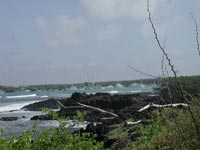 We
entered the Galapagos Islands, under overcast and drizzly skies,
May 16 at Puerto Ayora (Academy Bay) on Isla Santa Cruz. although
Santa Cruz is in the center of the archipelago, it was the port
of entry required by the peculiar red tape entangled around our
"zarpe" from Salinas, Ecuador. The good news was we actually
found the official we were supposed to find, and he indeed gave
us the time we'd been promised. Of course, he subsequently said
it would have been OK to enter at San Cristobal, which is the geographically
logical first stop. We
entered the Galapagos Islands, under overcast and drizzly skies,
May 16 at Puerto Ayora (Academy Bay) on Isla Santa Cruz. although
Santa Cruz is in the center of the archipelago, it was the port
of entry required by the peculiar red tape entangled around our
"zarpe" from Salinas, Ecuador. The good news was we actually
found the official we were supposed to find, and he indeed gave
us the time we'd been promised. Of course, he subsequently said
it would have been OK to enter at San Cristobal, which is the geographically
logical first stop.
Academy Bay
is an awkward anchorage. It faces South which leaves it pretty wide
open to the prevailing wind and swell. All the boats, which include
everything from fishing boats to large tour boats (including, to
my surprise the 148' three-master Alta, which Captain Rob &
Barb ran in the Virgins!), do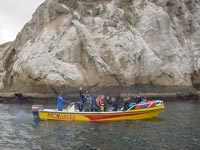 their best to crowd over to the protected side of the anchorage,
and stern anchors are required to keep all bows pointed into the
hefty swell. It is also one of those places that totally addles
my generally reliable internal GPS; the morning after our arrival
I would have sworn the sun was rising in the west! I never could
get it straight! Frankly, we were just grateful to see the sun,
for our first impressions of the Galapagos were somewhat anticlimactic.
On the charts, the archipelago of islands is almost reminiscent
of the Virgins, but in fact the islands are spread out with some
40 miles of water between them, and in the dismal grey they are
pretty much out of sight of one another! With the sunshin
their best to crowd over to the protected side of the anchorage,
and stern anchors are required to keep all bows pointed into the
hefty swell. It is also one of those places that totally addles
my generally reliable internal GPS; the morning after our arrival
I would have sworn the sun was rising in the west! I never could
get it straight! Frankly, we were just grateful to see the sun,
for our first impressions of the Galapagos were somewhat anticlimactic.
On the charts, the archipelago of islands is almost reminiscent
of the Virgins, but in fact the islands are spread out with some
40 miles of water between them, and in the dismal grey they are
pretty much out of sight of one another! With the sunshin e,
the whole aspect changed. The smooth volcanic slopes of Santa Cruz
swept up greenly to the summit of Cerro Crocker, only 864m high
but still wrapped in mist. It reminded us strongly of Nevis and
St. Kitts. e,
the whole aspect changed. The smooth volcanic slopes of Santa Cruz
swept up greenly to the summit of Cerro Crocker, only 864m high
but still wrapped in mist. It reminded us strongly of Nevis and
St. Kitts.
Between post-passage
recuperation and a few more encounters with red tape, (we were required
to have a fumigation certificate and the inspector failed to show
up two days in a row!), we got a slow start on our sightseeing.
The other problem we encountered was that, although Puerto Ayora
is the usual center of tour activity, the airport there was closed
for repairs. The result was most of the action had packed up and
moved over to Cristobal where the flights were then arriving! This
was a big handicap, becausein the Galapagos, we are not permitted
to just sail around and anchor wherever we might wish. Indeed, we
are limited to just four anchorages. Nor can you just climb in your
dinghy and venture out. Most access to "visitors sites"
and island "landings" is restricted to organized tours
with licensed guides. As you might guess the same restrictions apply
to scuba diving. Most cruisers who care bite the bullet and spend
the $$ to partake of both day and extended tours. Although it requires
leaving the boat, we were game. It just wasn't available!
Ashore on Santa
Cruz, however, there are several visitor sites we could walk to.
The first was the Charles Darwin Research Station. This is a well-designed
breeding center for the endanged Galapagos Tortoises, of which there
are eleven surviving subspecies (ten if you discount Lonesome George,
the lone remaining member of his!) Visitors can wander the paths
between naturally landscaped "corrals" and see the tortoises
from hatchlings on up to breeding adults. One corral houses tortoises
that were once pets, who se
exact subspecies is uncertain and which are therefore not included
in the breeding program. Visitors are allowed to get right down
into this corral up close to these tortoises. There was also a nice
exhibition on the natural history of the Galapagos, most of which
was already familiar to us from reading our various guidebooks.
(Check out "The Galapagos Islands" by Pierre Constant,
available in Borders Bookstore; nice photos.) se
exact subspecies is uncertain and which are therefore not included
in the breeding program. Visitors are allowed to get right down
into this corral up close to these tortoises. There was also a nice
exhibition on the natural history of the Galapagos, most of which
was already familiar to us from reading our various guidebooks.
(Check out "The Galapagos Islands" by Pierre Constant,
available in Borders Bookstore; nice photos.)
Our second Santa
Cruz excursion was a 3km walk over to Tortuga Bay. This was surprisingly
nice with a "path" paved in tiles which led through a
jumbled terrain of rugged lava rockswhere grow the arid-zone plants
of palos santos and cacti, including the quite intriguing Giant
Opuntia Cactus that actually has woody trunks! This gave us our
first exposure to the famously fearless Galapagos birdlife that
so struck Charles Darwin. Birds -- most notably the Galapagos mockingbird,
the vermillion flycatcher and a cactus finch -- would allow us so
close, that we repeatedly wondered who was checking out whom. One
little flycatcher female was quite fascinated with Don's ringlets
as we each inched closer and closer to one another. The path was
also a great place to make the acquaintance of various endemic geckos
and lava lizards. The white sand beach at the end of the trail would
have been the envy of any resort, yet the expanse was unmarred as
far as the eye could see and dotted only with a very few beachgoers
and surfers, most of whom we guessed to be young volunteers from
the research stati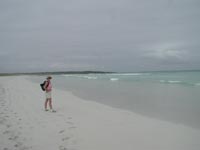 on.
Sunday we did our first two dives in the Galapagos (indeed, in the
Pacific!) at the justly famous Gordon Rocks. We were a little anxious
about jumping right in at this "advanced-rated" site given
that we hadn't dived since December and that we had a lot of new
cold-water equipment to inaugurate. Fortunately, the water was not
as cold as we feared, nor were the currents as stiff as advertised.
Unfortunately, visibility was also not as good aswe would have liked.
Still, what a dive!...sharks, manta rays (coasting along like some
sort of stealth bomber!), eagle rays, turtles (big), moray eels,
octopus, lobsters and a ton of fish! There were so many big fish
you couldn't even pay attention to the little ones, and all of them
are different from their cousins in the Caribbean! (Paul Humann,
the man responsible for the great set of Caribbean reef ID books
we have always used on TII, also has a Galapagos fish book.) Coming
up a few minutes before the others on the first dive, we were bummed
to find out we missed the hammerhead sharks! On the second dive,
we hoped to add the hammerheads to the day's list, but our divemaster
got disoriented and we spent half our time swimming hard in a huge
empty circle in midwater! The only thing we saw during that stretch
was a manta that cruised by curiously, clearly asking the very question
in all our minds: "What the hell are you guys doing out here!"
At the end, finally back at the rock, I lasted a few minutes longer
than Don and saw my first underwater sea lions scooting along the
base of a ravine, plus, just before on.
Sunday we did our first two dives in the Galapagos (indeed, in the
Pacific!) at the justly famous Gordon Rocks. We were a little anxious
about jumping right in at this "advanced-rated" site given
that we hadn't dived since December and that we had a lot of new
cold-water equipment to inaugurate. Fortunately, the water was not
as cold as we feared, nor were the currents as stiff as advertised.
Unfortunately, visibility was also not as good aswe would have liked.
Still, what a dive!...sharks, manta rays (coasting along like some
sort of stealth bomber!), eagle rays, turtles (big), moray eels,
octopus, lobsters and a ton of fish! There were so many big fish
you couldn't even pay attention to the little ones, and all of them
are different from their cousins in the Caribbean! (Paul Humann,
the man responsible for the great set of Caribbean reef ID books
we have always used on TII, also has a Galapagos fish book.) Coming
up a few minutes before the others on the first dive, we were bummed
to find out we missed the hammerhead sharks! On the second dive,
we hoped to add the hammerheads to the day's list, but our divemaster
got disoriented and we spent half our time swimming hard in a huge
empty circle in midwater! The only thing we saw during that stretch
was a manta that cruised by curiously, clearly asking the very question
in all our minds: "What the hell are you guys doing out here!"
At the end, finally back at the rock, I lasted a few minutes longer
than Don and saw my first underwater sea lions scooting along the
base of a ravine, plus, just before reaching the surface, an ethereal school of 14 golden cownose rays
(we don't have anything like them in the Caribbean)!
reaching the surface, an ethereal school of 14 golden cownose rays
(we don't have anything like them in the Caribbean)!
Despite all
this, the real highlight of the day was our rest stop between the
dives. There, in a slot of water between the Plaza Islands, we got
to get in the water and snorkel with a whole tribe of sea lions.
While the fat old adults lounged around on boulders, the youngsters
happily played with us. Incredibly COOL! Imagine going to a pet
store and standing in the middle of the big pen they keep the puppies
in. These guys just swam up to us and looked us right in the eye,
then with a flip of their front flippers they'd roll upside down
under you and blow bubbles or nip at the ends of our fins. A couple
had little rocks in their mouths which they would toss out like
a ball only to chase after them as they fell, grab them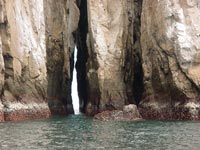 in
their mouths again, swim to the surface and then do it over. When
they swim, their rotund little bellies seem to twist independently
of their skin, so that it is hard to keep track of which way is
up! in
their mouths again, swim to the surface and then do it over. When
they swim, their rotund little bellies seem to twist independently
of their skin, so that it is hard to keep track of which way is
up!
Monday morning
at the crack of dawn we hauled up our two anchors and motored/sailed
42 miles back east to San Cristobal to rendezvous with Lite N Up,
arriving that day from Salinas. In the process we "caught"
probably the biggest fish we have ever hooked, about a 5 foot Wahoo(great
eating). Unfortunately, it was not a "real" catch, as
the wiley critter broke the line right at the stern of the boat
by diving under the rudder. We had two more good hits after that,
but both times the line or lure broke loose. So after losing about
$30.00 worth of equipment, we gave up on the fishing.
Wreck
Bay, San Cristobal
Latitude: 00-53.70S; Longitude: 089-36.70W
Wreck Bay is
a world away from Academy Bay. We cruised in and dropped the hook
at the back of the pack in 30' of clear water, and sighed happily
as the boat settled back quietly! No more swell! What a concept,
a protected anchorage! Up ahead were fishing boats with the fat
hulks of sea lions sprawled on them, and several swam by Tackless
II as if to greet us. This is kind of more what we had imagined!
Not only had
Lite N Up arrived, but about four more cruising boats whose voices
we had come to know on the morning radio net. One was Magic Four,
a family of four from Australia, and another (we kid you not) Up
Chuck, four middle-aged guys from Manchester, England. In the way
that is peculiar in the cruising community, we suddenly found ourselves
with an instant social circle, which we have exercised in several
establishments in town. Also we had our young Peace Corps friend
Amy, whom we'd met in Bahia. She is now stationed here as a volunteer
with the Charles Darwin Foundation to develop small business projects
with the local fishermen's wives. Only here a few weeks herself,
she has already made many connections, including one with the owner
of the local dive shop!
Which brought
about Wednesday's dive trip to Kicker Rock (aka Leon Dormido or
"Sleeping Lion".) Kicker Rock is one of the awesome volcanic
"tuff" formations that abound in the Galapagos. It sticks
up from the sea in a truly vertical thrust, 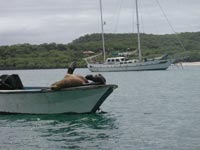 and
a split in the formation allows boats to motor through it! It is
also rated as an excellent site to see hammerheads. Nothing is easy,
however. Chalo's Dive Tours, the "operation" owned by
Amy's friend, has a broken air compressor. Step in Tackless II Dive
Charters. We'll fill the tanks and barter the service for our dive.
No problem. Don fills eight shop tanks, and the next morning, off
we go with a boatload that included John from Magic Four and Frank,
Hugh and Mike from Upchuck, plus Victor, our local divemaster. I
was very impressed with the speedy and smooth ride out to the dive
site, which the guidebook described as a three-hour boat trip. The
big 125hp outboard on the dive boat made it in a half hour! We made
two dives on the rock, essentially in the same place, and this time
we did indeed see our hammerheads! Quite close in fact! Several
of them! We also saw Galapagos shark, silver shark, huge turtles,
an eagle ray, several morays, another octopus, and a lobster along
with several billion creole wrasse and an equal number of urchins
and sea biscuits lining the near vertical wall! Even with four Galapagos
dives under our belts, the 2Cs are still stunned by the volume and
size of all these sea creatures. In the Caribbean, we'd be thrilled
with a ray or a shark a week! For Hugh and Mike it was only their
third or fourth dive since certification! I think they're going
to be ruined for life! and
a split in the formation allows boats to motor through it! It is
also rated as an excellent site to see hammerheads. Nothing is easy,
however. Chalo's Dive Tours, the "operation" owned by
Amy's friend, has a broken air compressor. Step in Tackless II Dive
Charters. We'll fill the tanks and barter the service for our dive.
No problem. Don fills eight shop tanks, and the next morning, off
we go with a boatload that included John from Magic Four and Frank,
Hugh and Mike from Upchuck, plus Victor, our local divemaster. I
was very impressed with the speedy and smooth ride out to the dive
site, which the guidebook described as a three-hour boat trip. The
big 125hp outboard on the dive boat made it in a half hour! We made
two dives on the rock, essentially in the same place, and this time
we did indeed see our hammerheads! Quite close in fact! Several
of them! We also saw Galapagos shark, silver shark, huge turtles,
an eagle ray, several morays, another octopus, and a lobster along
with several billion creole wrasse and an equal number of urchins
and sea biscuits lining the near vertical wall! Even with four Galapagos
dives under our belts, the 2Cs are still stunned by the volume and
size of all these sea creatures. In the Caribbean, we'd be thrilled
with a ray or a shark a week! For Hugh and Mike it was only their
third or fourth dive since certification! I think they're going
to be ruined for life!
Remember I said,
nothing is easy? Trouble started on the way back when the giant
outboard developed a knock that grew worse and worse (and we went
slower and slower) until the engine up and quit! The boys went back
and tinkered to no avail. No, shit, there we were, about eight miles
away from home along a completely undeveloped coast! Do we have
a radio? Surely, you jest. It's about 3 o'clock in the afternoon!
We decided our best, most realistic goal was to get to Los Lobos,
home of a sea lion colony popular with tour boats. The divers jumped
in with mask and fins and we started towing and pushing the dive
boat toward our goal. There were skeptics mind you, but in fact
we made it to within a half mile before we were rescued by a lobster
boat and shortly after by a park service boat. We all bought lobsters
from the lobster boat.
Now, all those
empty tanks (14) came back to Tackless II, and Don and Victor got
together yesterday to fill them. The idea was that we'd leave Victor
to run 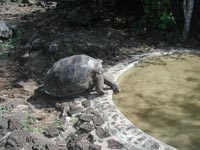 the
compressor while we went island touring, but the day was full of
small challenges. First, the bleed valve (about the size of a nickel)
on the fill hose flew off and overboard, which resulted in a search
of the bottom on scuba by Victor and me, which, miraculously produced
the piece. (Thank you St. Anthony!) Next problem, the fill hose
fails. This is the NEW hose we had made a mere month ago in Quito.
Hmm. So Victor went off to get the hose off their non-functioning
compressor, which, of course turned out to have different fittings.
The boys prevailed, BUT by then it's 3:00 in the afternoon and they
still had six tanks to go! The pressure was on because we had a
big group trip planned for Friday with two boats, half to dive again
and half to snorkel, with a picnic at Los Lobos, the sea lion island.
We will take our OWN hand-held radio! the
compressor while we went island touring, but the day was full of
small challenges. First, the bleed valve (about the size of a nickel)
on the fill hose flew off and overboard, which resulted in a search
of the bottom on scuba by Victor and me, which, miraculously produced
the piece. (Thank you St. Anthony!) Next problem, the fill hose
fails. This is the NEW hose we had made a mere month ago in Quito.
Hmm. So Victor went off to get the hose off their non-functioning
compressor, which, of course turned out to have different fittings.
The boys prevailed, BUT by then it's 3:00 in the afternoon and they
still had six tanks to go! The pressure was on because we had a
big group trip planned for Friday with two boats, half to dive again
and half to snorkel, with a picnic at Los Lobos, the sea lion island.
We will take our OWN hand-held radio!
Well, the day
trip went without a hitch. What made it particularly fun was the
conglomeration of cruising boat crews that had been getting to know
one another. We had six divers, and although it was the same dive
site we had already done Wednesday (Kicker Rock), the visibility
was so much improved that it was like being in a different place.
Unfortunately, there was only one hammerhead, and Baker, on his
first dive in years, missed it. A highlight for the 2Cs was a sea
lion that passed us at 80 feet, heading down out of sight like a
torpedo! What was he after? Meanwhile a passle of eight or so snorkelers
putzed about the great rock on the surface. After the dive, we moved
both boats to Las Lobos to play with the sea lion colony there during
lunch, and then the divers made a shallow dive nearby, the highlight
of which were several sea lions who played with us at depth! We
also saw our first marine iguanas (they actually feed on algae underwater!)
and a lot of seabirds including blue-footed boobies, frigatebirds,
and a great blue heron. All boats made it home without problem this
time, and all in all a good time was had by everyone. Don, however,
insists it will be the last time we put ourselves in such an "organizational"
position. Retired is retired.
We capped the
day off with a mass dinner at a really good restaurant in town called
Albacora. There 21 gringos filled the tables, and the owners produced
a great meal in a timely manner. Unfortunately, several of us are
down with the revenge yet again, which is keeping us close to home
and putting a damper on today's land touring plans. Baker and Cindy
and Amy have a friend flying in this afternoon from Bahia for a
week's visit, and the 2Cs are getting ready to move on.
|